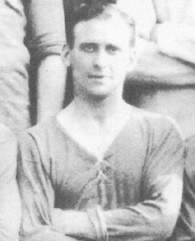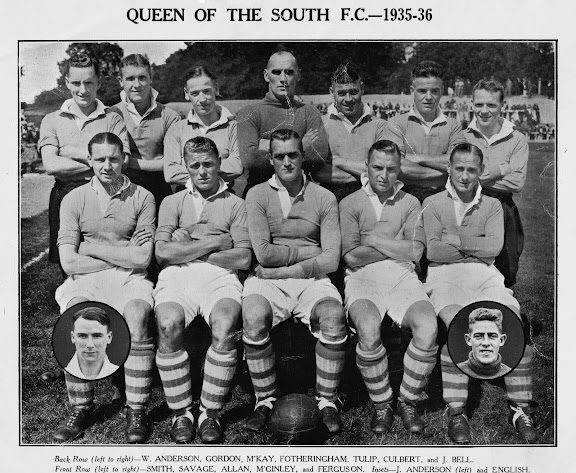Willie Ferguson had a short spell with Queen of the South early in his career before spending a decade at Chelsea. He returned to QoS as player and then manager at Queen of the South during the 1930s experiencing many of the greatest moments in the club’s history. Ferguson usually played as either left wing or wing half.
Queen of the South (1st spell)
A native of Muirkirk, William Copeland Ferguson was born on 13 February 1901 and was still a child when his family moved to Kirkconnel. It was there with local side Kello Rovers that Ferguson started in football. He then played for Queen of the South when QoS were still a developing non league club. Ferguson’s debut was on 12th November 1921 in a 1-1 draw against Stevenson. The season’s highlight for the Doonhamers was a very respectable Scottish Cup run. Blairgowrie Amateurs and Inverness Citadel were beaten before Ferguson scored both goals in a 2-0 third round win over East Stirlingshire. Ferguson had the ball in the net in between his two counters but the strike was chalked off. The next round was a quarter finals appearance on 11th March 1922 against the club who finished that season as the sixth best side in Scotland, Partick Thistle. QoS were eliminated by a solitary goal but still able to take some credit as a non league club having made it to the quarter finals.
Ferguson’s talents attracted big name attention elsewhere. While QoS were still very much a fledgling outfit, there at least appeared to be something right in the club scouting system. Since the 1919 club formation, Ferguson became no less than the seventh player to have passed through Palmerston on his way to a career in England’s top division along with
Ian Dickson,
Dave Halliday,
Hughie Gallacher, and the three players who went to Blackburn Rovers; Tom Wylie, Jimmy McKinnell and Willie ’Puff’ McCall.
Chelsea
In joining Chelsea, Ferguson was by no means first the connection the club had with Dumfriesshire.
David Calderhead had played with predecessor to Queen of the South, Queen of the South Wanderers, for 8 years gaining 1 full Scotland cap. As manager he moved from Lincoln City to Chelsea in 1907 after knocking the Londoners out of the FA Cup. Norrie Fairgray from Dumfries scored the Lincoln goal and made the same move in the same year to play under Calderhead at both clubs. Fairgray later joined QoS in 1919. Angus Douglas also joined Chelsea in 1907, from his home town club Lochmaben F.C. Douglas played for Scotland once whilst at Chelsea before World War 1 stopped his career when he was then at Newcastle. After surviving the war Douglas succumbed to the Spanish flu pandemic of 1918 that killed over 50 million people worldwide. Like Fairgray and Douglas, it was who Calderhead managed Ferguson at Chelsea.

Willie Ferguson broke into the Chelsea first team in 1923/24 playing on the left wing scoring once in 27 games. The young Ferguson suffered the disappointment of relegation. Ferguson’s goal was against eventual champions Huddersfield Town.
In 1924/25 Ferguson was switched to the position where he spent most of his Chelsea career – left half. Ferguson played 30 games that season with the club missing out on promotion finishing fifth. Ferguson scored at home and away against Blackpool. In 25/26 Ferguson played in 27 games as Calderhead’s side missed out on promotion by one place – Chelsea finished third behind The Wednesday (as the Sheffield club were then known) and Derby County.
Season 26/27 was that of Ferguson’s greatest number of appearances at Stamford Bridge – 42 with three goals scored. Chelsea enjoyed a cup run to the FA Cup quarter finals. Ferguson played in front of a monster crowd at Stamford Bridge, 70,184 fans shoe-horned in for the 0-0 draw. Playing against Ferguson was his future manager at Queen of the South,
George McLachlan of Cardiff City. Ferguson lost out as Cardiff won a dramatic replay 3-2.
In 27/28 Ferguson played 41 times finding the target once himself. Chelsea again missed promotion by one place – Man City and Leeds were the promoted sides.
Season 28/29 was a major disappointment with Chelsea failing to challenge seriously and finished ninth. No goals from Ferguson in his eleven games.
At the season’s end Ferguson embarked upon an adventure that would serve him well in the future at QoS - he was a key part of Calderhead’s squad that went on Chelsea’s groundbreaking three-month tour of Argentina, Brazil and Uruguay (used by the Uruguayans as practice for hosting the first ever World Cup in 1930).
Calderhead’s Chelsea became the first professional English club to play in São Paulo in July 1929 (Ferguson played). Chelsea were also the first side to play there with shirt numbers earning them the nickname of ’Los Numerados’.
In 1929/30 it was promotion at last for Calderhead and Ferguson as Chelsea were promoted back to the top tier in second place behind Blackpool. Ferguson played only 11 games, scoring twice. However Ferguson played in all four of the final crucial games that clinched promotion.
To capitalise on the 1930 promotion, Calderhead spent £25,000 on three big-name internationals. The English lads in the Chelsea squad must have occasionally felt like immigrants as the signings were yet more Scots. Inside forward Alec Cheyne is the man credited with having started the Hampden roar with his 1929 last minute winner against England. Winger Alex Jackson was a Wembley Wizard and a player who had won the league championship at Huddersfield. The third was another of the Wembley Wizards, the one and only
Hughie Gallacher.
Trophies remained elusive. Some felt money wasn’t spent wisely; expensive forwards were signed while defence strengthening remained secondary. The 1932 FA Cup run was to be the closest Ferguson came to silverware. Ferguson played in all seven cup games that season as did Jackson.
Gallacher scored in all of the 5 games he played in hitting six goals that season in the competition. Joining the competition at the third round, a trip away to Wirral side Tranmere Rovers ended 2-2. In a goals-galore replay Chelsea went through 5-3. West Ham were then defeated 3-1 in the fourth round at the Bridge. The next round needed a replay against a club who had re-named in 1929 - they were now called Sheffield Wednesday. 1-1 in Sheffield, 2-0 in London. Then in the quarter finals came arguably their season’s best result, a 2-0 win at Anfield against Liverpool.
The semi was played at Leeds Road in Huddersfield. It was to be the day of a forward now in history as a man who scored goals for Queen of the South. It was neither Ferguson nor Gallacher. Newcastle United’s
Tommy Lang scored one and made another giving his side a 2-0 lead. Gallacher’s goal wasn’t enough to save Chelsea. It was a long journey home for Ferguson on the end of a 2-1 final score. In a similarity to George McLachlan, Lang went via Manchester United before ending up at Palmerston. Lang joint top scored in one of QoS finest ever sides, the team that finished sixth in the top division in 1938/39.
Ferguson remained a familiar name on the Chelsea team sheet in the 30s playing 25, 21 (scoring twice) and 17 games respectively in the first three seasons to start in that decade. He played regularly among his star studded team mates and very occasionally even deputised for Gallacher at centre forward. However in his last Chelsea season he figured mostly at inside left.
Until his departure in 1933 Willie Ferguson made 294 Chelsea first team appearances scoring 11 goals. 1932-33 was similarly the last at Stamford Bridge for David Calderhead. His club record 966 games in charge spanned 26 years.
In Tony Matthews’ 2005 publication, ’Who’s who of Chelsea’, the promotional summary states the following:
"Their great players include Jimmy Greaves, Peter Osgood, Gianluca Vialli, Terry Venables, David Webb, and other superstars from yesteryear, including George Barber, Jackie Crawford, Willie Ferguson, Bobby McNeil, and Tommy Walker. As well as providing full details on these legends and many others..."
St Bernard’s
After 17 games for Chelsea in 1932/33, Ferguson returned to Scotland to play the same number of games for an Edinburgh club to have since gone defunct, St Bernard’s.
Queen of the South (2nd spell)
Ferguson rejoined Queen of the South as the club’s notable signing in the Summer of 1933 ahead of the club’s debut season in Scottish Football’s top division. They had been promoted as runners up to Hibernian the season before. Willie’s brother Pearson Ferguson played five games for QoS between January and April of the previous season. The two never played on the same QoS side together.
QoS enjoyed a highly successful first season in the top division finishing 4th - their highest finish to date. The detail on that season is in the article on Ferguson’s team mate, full back Willie Savage. QoS also returned to the quarter finals of the Scottish Cup for the first time since the Ferguson inspired campaign in 1922.
In 1935, QoS appointed one of Ferguson’s former FA cup opponents as manager – George McLachlan. Ferguson brought his experience to great effect. In the Summer of 1936 the Doonhamers ventured forth on a 1 month tour to France, Luxembourg and Algeria. With Ferguson an old hand at touring overseas from the three month Chelsea trip to South America, his experience could be utilised by the rest of the travelling entourage. Tuned into Ferguson’s frequency, Ireland’s sand dance style Laurie Cumming gleefully put away chance after chance teed up by Ferguson’s creative craftsmanship. More detail on the QoS 1936 Overseas tour is in the Queen's Legends feature on George McLachlan.

Ferguson combined playing with coaching the reserve side in 1936/37, earning much praise. Ferguson took over from George McLachlan as QoS manager in 1937. Ferguson gave
Jackie Oakes his first team debut shortly after taking over. Ex Scotland defender Phil Watson was signed by Ferguson in 1938. Another to figure prominently in Ferguson’s reign was another player featured in Queen's legends,
George Hamilton.
Ferguson’s most notable result as manager was at Ibrox Park, the first time when QoS condemned Rangers to a league defeat (QoS had condemned Rangers to a Scottish Cup defeat the season before at Palmerston Park before making it to the quarters). The detail on this Ibrox win is in the George Hamilton article.
After five seasons in the top flight and a popular figure at QoS, it was a surprise when Ferguson announced his resignation in the Summer of 1938. Ferguson wanted to focus on his confectionary and tobacconist business recently acquired from ex-QoS goalkeeper, George Woods.
Ferguson was succeeded as manager by Jimmy McKinnell Snr on July 2nd 1938, the day on which Ferguson’s contract was terminated after his resignation.
Later years
Willie Ferguson owned the confectionary and tobacconist shop on Great King St in Dumfries opposite the G.P.O. His son Chris ran the business until the early 1990s.